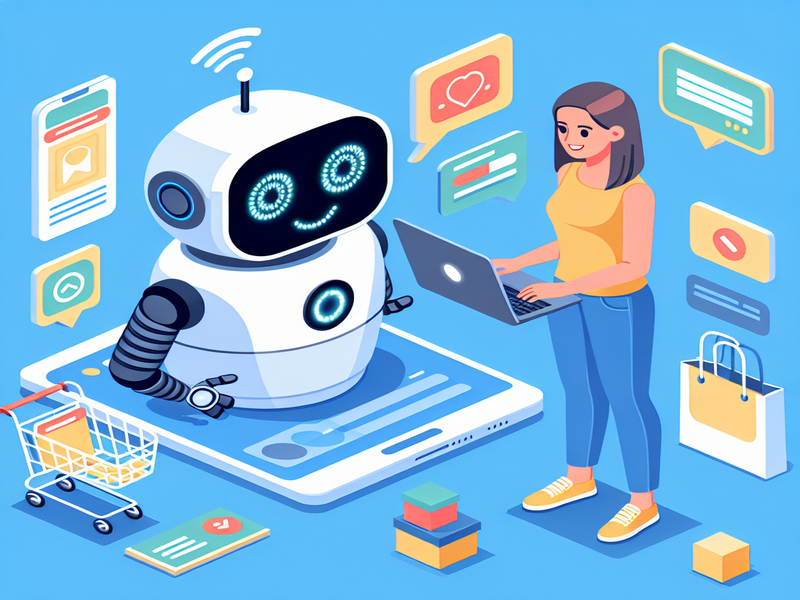- Updated: July 29, 2024
- 5 min read
Building AI-Powered Chatbots to Drive Sales in Retail
Introduction to AI-powered chatbots in e-commerce
In the ever-evolving landscape of e-commerce, businesses are constantly seeking innovative ways to enhance customer engagement and drive sales. One technology that has emerged as a game-changer is the AI-powered chatbot. These intelligent virtual assistants, powered by advanced natural language processing (NLP) and machine learning algorithms, are revolutionizing the way businesses interact with their customers.
As we approach the second half of 2024, the e-commerce industry is gearing up for major shopping events like Singles’ Day, Cyber Monday, and End of Year festivities. This presents a critical opportunity for retailers to leverage AI-powered chatbots to captivate and engage with a vast consumer audience. By seamlessly integrating these intelligent assistants into their digital platforms, businesses can provide personalized and efficient customer service, ultimately boosting sales and customer loyalty.
Benefits of AI chatbots for customer service
AI-driven customer service chatbots have transformed the customer experience at every stage of the sales funnel. These virtual assistants offer a myriad of benefits, including:
- 24/7 Availability: Chatbots operate around the clock, ensuring that customers receive prompt assistance whenever they need it.
- Personalized Interactions: By leveraging customer data and machine learning, chatbots can tailor their responses to each individual, creating a more personalized and engaging experience.
- Efficient Problem-Solving: Chatbots can handle a wide range of customer inquiries, from answering FAQs to processing orders, customizing offers, and managing returns, all with speed and accuracy.
- Scalability: Unlike human agents, chatbots can handle a large volume of customer inquiries simultaneously without compromising service quality, making them particularly valuable for small business owners.
According to Verint’s 2023 State of Digital Customer Experience report, 31% of consumers have higher customer service expectations than the previous year, and a staggering 69% have ceased doing business with a company due to a single poor customer experience. By implementing AI-driven customer service technologies like chatbots, businesses can meet these rising expectations and deliver consistent, high-quality experiences across all touchpoints.
How generative AI enhances chatbots
Generative AI models, such as large language models (LLMs), have revolutionized the way chatbots can be trained to mirror a brand’s unique personality and voice. By incorporating brand-specific guidelines, tone, and language, businesses can develop chatbots that seamlessly embody their identity, ensuring a cohesive and authentic customer experience across all digital channels.
For instance, H&M’s generative AI chatbot on their website can reduce response times by up to 70% compared to human agents. Euromonitor International’s customer experience report found that 56.2% of Chinese consumers used voice assistants in 2023 while making purchases. This chatbot assists shoppers in searching for specific products, answers FAQs, and helps with orders, providing a more straightforward and satisfying experience for customers while significantly easing the burden on the customer service team.

Steps to build effective AI chatbots
When developing an AI chatbot for customer service, several key steps ensure its effectiveness:
- Define the Objective: The primary goal should be to efficiently resolve customer inquiries while reducing workload. Brands should analyze common customer intents to identify areas where automation can have the most impact.
- Train with Quality Data: Collect valuable behavioral data from customer and agent interactions across various channels, as well as surveys and other feedback. For example, the Verint Intent Discovery Bot uses advanced AI to process customer data from multiple channels, enabling it to understand customer queries accurately and help intelligent virtual assistants (IVAs) provide better responses in the future.
- Utilize Data and Analytics: Once operational, use data and analytics, such as the number of conversations, average response time, user engagement, and conversation completion rates, for optimization. Establish a systematic feedback process to measure performance, intent recognition, and advice effectiveness. This ongoing analysis and optimization process ensures the chatbot gains deeper customer insights and continually improves to deliver optimal customer service.
- Understanding where human agents value-add: While AI technology continues to become increasingly advanced, there will always be times where a human agent will be needed. This is especially true for high-value transactions, high-value customers, or managing complex requests. In this sense, AI chatbots can be used to manage high-volume, low-complexity tasks – freeing up human support agents to manage the lower-volume, but higher-complexity requests.
Potential of chatbots as revenue generators
While older chatbots were typically used for post-sales or general inquiries, advanced AI-powered chatbots now have the potential to transform the customer experience in e-commerce. They can shift chatbots from being cost centers to becoming revenue generators.
By leveraging advanced AI technologies, brands and e-commerce merchants can ensure round-the-clock availability, personalized interactions, and efficient query resolution, leading to higher customer satisfaction and loyalty. This, in turn, can drive increased sales and revenue growth.
Furthermore, chatbots can be integrated with marketing strategies, providing personalized product recommendations, upselling opportunities, and even facilitating seamless checkout processes. By offering a seamless and engaging shopping experience, businesses can foster long-lasting customer relationships and cultivate brand loyalty.
Conclusion
In the competitive e-commerce landscape, businesses that embrace advanced AI-powered chatbots have a significant opportunity to stay ahead of the curve. These intelligent virtual assistants not only enhance customer service but also have the potential to drive revenue and sales growth.
As the adoption of generative AI and natural language processing technologies continues to accelerate, businesses that prioritize the integration of AI-powered chatbots into their digital platforms will be well-positioned to captivate and engage with customers, ultimately fostering long-term success in the rapidly evolving digital marketplace.
To learn more about leveraging AI-powered chatbots and other cutting-edge technologies for your business, explore the UBOS platform and templates designed to streamline your digital transformation journey.
